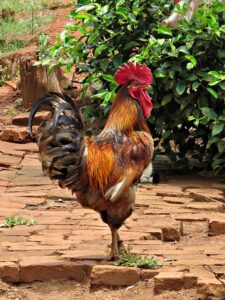Chickens might not seem like the most complex creatures when they’re clucking around your yard, but their social interactions are anything but simple. They have full-on hierarchies, intricate communication methods, and personalities that would make even your quirky uncle jealous. Understanding chicken behavior and pecking order isn’t just fascinating—it’s essential for keeping a happy, healthy flock.
If you’ve noticed your birds doing some odd things—like puffing out their feathers, pecking at each other’s heads, or making alarm sounds that could rival a fire truck—you’re not alone. Welcome to the world of chicken behavior and the glorious (and sometimes brutal) pecking order.
Chicken Social Structure
When it comes to chickens, they don’t just coexist—they operate under an unspoken (and occasionally clucked) set of rules that keeps the flock running smoothly.
The term “pecking order” isn’t just a fun phrase; it’s a very real social hierarchy that defines who’s boss and who’s not. It impacts everything—who eats first, who roosts where, and who has first dibs on all that prized dust in the dust bath. Understanding this pecking order is vital if you want to keep your flock harmonious.
Why Does It Matter?
Without understanding their social structure, you might misinterpret normal behaviors as problematic. Think of the pecking order as a chicken’s way of voting someone in as president… or at least head chicken. Everyone else works out where they fit, sometimes with a little drama for good measure.
Chicken Communication 101
Chickens don’t have verbal arguments or written contracts (imagine if they could sign official coop agreements!), but they do communicate in subtle but clear ways.
Vocal Communications
Chickens have a surprisingly rich vocabulary. Here’s the breakdown of what their clucks, squawks, and coos mean:
- Contentment Sounds: These soft, gentle coos say, “Life is good.” You’ll often hear them when chickens are foraging or sunbathing.
- Alarm Calls: This is like the flock’s security system. A short, sharp call says, “Danger nearby!” and you’ll see the flock instantly become more alert.
- Egg-Laying Announcements: You’ll know when a hen has laid an egg because she will announce it to the world. This proud clucking (a.k.a. the “egg song”) is unmistakable.
Body Language
While vocalizations are important, a chicken’s body often does most of the talking.
- Posture: A dominant bird often stands tall with an upright posture, while a submissive one crouches low.
- Feathers and Wings: Raised hackles (neck feathers) indicate a challenge, while relaxed wings mean all is calm.
- Tail Position: A drooping tail might mean illness or stress, so always keep an eye out for these subtle signs.
Behavioral Signals and Their Meanings
A. Aggressive Behaviors
Even in the most peaceful flocks, aggressive behaviors can occasionally occur as part of social dynamics. Here are some common signs of aggression in chickens and what they mean:
- Chest Bumping
This is like a chicken’s version of a face-off. Two birds will puff up their chests and bump into each other to establish dominance without resorting to serious fighting.
- Hackle Raising
When a chicken raises its neck feathers (hackles), it’s a clear warning sign. This dramatic display says, “Back off!” and often signals an imminent scuffle if neither bird retreats.
- Direct Staring
A hard, unblinking stare between chickens can be surprisingly intense. This behavior is a silent challenge, with each bird sizing the other up before deciding whether to escalate or back down.
- Pecking and Chasing
Pecking is often used to reinforce social standing, while chasing is a way to assert control over personal space. While minor pecks are common, persistent pecking or aggressive chasing should be monitored to prevent injury.
B. Submissive Behaviors
- Crouching
Crouching is a common sign of submission in chickens. A submissive bird may lower its body close to the ground, with wings slightly spread, to signal deference to a dominant bird. This behavior helps to avoid conflict and maintain harmony within the flock.
- Avoiding Eye Contact
Chickens that avoid eye contact are often trying to communicate submission. By refusing to engage directly, the submissive bird is essentially saying, “I’m no threat,” which helps to de-escalate potential challenges.
- Moving Away from Dominant Birds
Submissive birds will frequently move aside or walk away when a dominant bird approaches. This respectful distance allows the dominant chicken to maintain its perceived authority without confrontation.
C. Courtship and Mating Behaviors
- Rooster Courtship Displays
Roosters have a variety of courtship behaviors designed to win the favor of hens. One common display is tidbitting, where a rooster finds food and makes a distinctive “clucking” sound to call over a hen, often picking up and dropping the food as an enticement. Roosters may also perform a dance known as “wing dragging,” where they lower one wing and circle around the hen while shuffling their feet. These displays are meant to showcase the rooster’s strength, attentiveness, and suitability as a mate.
- Hen Receptivity Signals
Hens display clear signals when they are receptive to mating. A common sign is the “submissive squat,” where the hen crouches low to the ground with her wings slightly outstretched, making it easier for the rooster to mount. Receptive hens may also stay close to a favored rooster and follow him around, signaling their willingness to mate. These behaviors ensure successful mating without unnecessary aggression or confusion within the flock.
The Pecking Order
Ah, the infamous pecking order. Some birds are leaders, some are followers, and occasionally, one will endure the title of “bottom chicken.”
What Is the Pecking Order?
This term originally came about from, you guessed it, observing chickens. The top-ranking hen gets first dibs on food, roosting spots, and space, while everyone else falls into their respective places.
- Dominance Behaviors include chest bumping, chasing, and pecking.
- Submission Signals often see lower-ranked hens moving away or avoiding eye contact.
Factors that Affect the Pecking Order
Not all chickens start on an equal playing field. Factors like age (older hens often dominate), size, breed traits, and even an individual personality play a role in determining rank. Large, bold breeds like Rhode Island Reds might climb to the top faster than more docile varieties like Silkies.
Behavioral Signals and Their Meanings
If you’ve noticed specific quirks in your flock, chances are they mean something.
Aggression Behaviors
- Chest Bumping: Basically, the chicken version of a bar brawl.
- Hackle Raising: A surefire sign of confrontation on the horizon.
- Pecking: Used to assert dominance or reprimand subordinates.
Submissive Behaviors
- Crouching shows respect to higher-ranking birds or even signals readiness during courtship.
- Avoiding Eye Contact is the chicken’s way of saying, “I know you’re the boss. I’m not challenging that!”
Courtship Displays
Roosters, oh roosters. These guys will fluff up, dance (yes, really), and even “tidbit” (offering food to a hen) to win her affection.
Tips for Managing Your Flock
While chickens usually work out their social dynamics on their own, there are times you might need to step in for your flock’s well-being.
Adding New Chickens
Introducing new birds to an established flock can be chaotic. To make it less stressful for everyone involved, try these tips:
- Slowly integrate the newcomers by keeping them in a separate pen within sight of your existing flock for a week or two.
- Ensure there’s enough space for everyone to spread out. (Cramped quarters = feisty chickens!)
- Monitor for excessive aggression. Some pecking is normal, but bullying isn’t.
Keeping the Peace
Here’s how you can create a more harmonious environment for your flock:
- Provide plenty of feeding stations—no one likes being cut off from their meal.
- Avoid overcrowding. Each chicken needs about 4 square feet of coop space and 10 square feet of run space.
- Enrich their environment. Add perches, dust baths, and even a few treat-dispensing toys to keep them busy.
Chicken Personality? Yes, It’s a Thing
Not all chickens are created equal. While some are bossy and brash, others are gentle and shy. Breed often plays a role, but experiences (positive or negative) can deeply influence a chicken’s temperament.
Health and Behavior
A sick chicken might act out of character, so keeping an eye on health is crucial. Be wary of sudden aggression or lethargy—these could be signs of illness that need addressing immediately.
A Happy Flock = A Happy Keeper
The more you understand your chickens’ behavior, the better equipped you’ll be to keep them happy, healthy, and safe. Observation is your best tool—spend some time watching them and you’ll pick up on quirks that make managing your flock a breeze.
Want more tips for creating a peaceful coop? Don’t forget to bookmark this blog and share your best chicken stories below in the comments—because we know every chicken keeper has a funny feathered tale to tell! 🐔
For more on chicken care:
Chicken Emergency Preparedness
Chicken Egg Quality Enhancement
How Many Chickens do you Need?
Using Chickens for Pest Control
Navigating Chicken Zoning Laws
Chicken Respiratory Infections: Herbal Options
Fermenting Herbs for Chicken Gut Health
Chicken Foraging and Free Ranging
Best Chicken Breeds for Egg Laying
Safely Introducing New Hens to Your Flock

